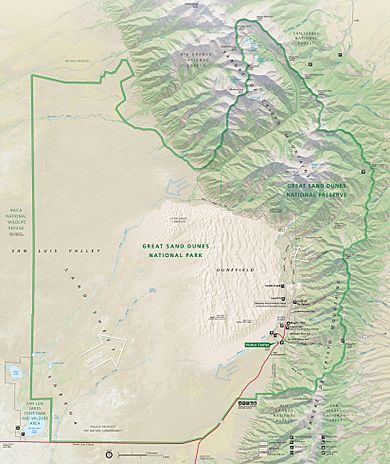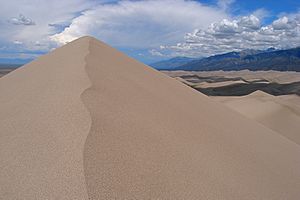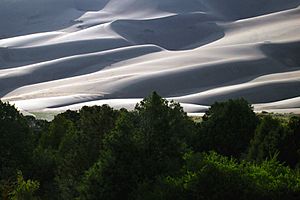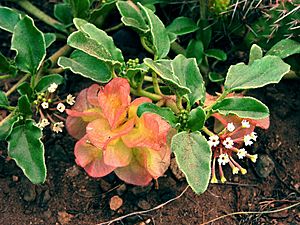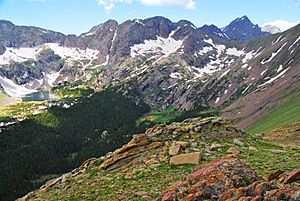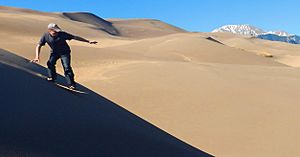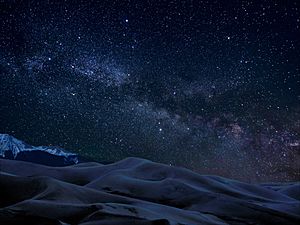Great Sand Dunes National Park and Preserve facts for kids
Quick facts for kids Great Sand Dunes National Park and Preserve |
|
|---|---|
|
IUCN Category V (Protected Landscape/Seascape)
|
|
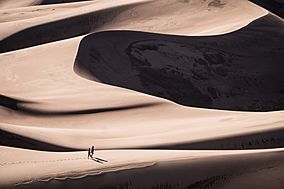
Hikers traversing a dune at the park
|
|
| Location | Alamosa and Saguache Counties, Colorado, United States |
| Nearest city | Alamosa |
| Area | 149,028 acres (232.9 sq mi; 603.1 km2) |
| Established | March 17, 1932 (as a national monument) September 24, 2004 (as a national park) |
| Visitors | 527,546 (in 2019) |
| Governing body | National Park Service |
The Great Sand Dunes National Park and Preserve is a special place in south-central Colorado, United States. It protects the tallest sand dunes in North America, which can reach up to 750 feet (230 m) high! Imagine climbing a sand mountain taller than many skyscrapers.
This amazing park is located on the eastern edge of the San Luis Valley. Next to the dunes, there's also a national preserve in the Sangre de Cristo Range. The area first became a National Monument in 1932. Later, in 2004, it became a full national park and preserve, making it much larger. Today, the park and preserve cover a huge area of 149,028 acres (232.9 sq mi; 603.1 km2). Many people visit each year to explore this unique desert and mountain landscape.
Contents
History of the Dunes
Early People
People have lived in the San Luis Valley and around the Great Sand Dunes for about 11,000 years. The first people were nomadic hunter-gatherers. They hunted large animals like mammoths and ancient bison using stone spears. They only stayed when there was enough food and water.
Later, different Native American tribes knew about the dunes. The Southern Ute Tribe called them Saa waap maa nache, meaning "sand that moves." The Jicarilla Apaches called them Sei-anyedi, meaning "it goes up and down." Blanca Peak, a mountain near the dunes, is sacred to the Navajo people.
These tribes used the inner bark of ponderosa pine trees for food and medicine. Some pueblo tribes from the Rio Grande area also believe their people came into the world from a lake near the dunes. They called it Sip'ophe, or "Sandy Place Lake."
European Explorers and Settlers
The first European to explore the San Luis Valley was Diego de Vargas in 1694. He and his men hunted bison in the valley. Later, explorers like Juan Bautista de Anza and Zebulon Pike also traveled through the area.
In 1807, Zebulon Pike wrote about the dunes, describing them like "the sea in a storm." He noted that no plants grew on them. Other explorers, like John C. Frémont and John Gunnison, also passed through the valley in the 1800s.
After the explorers, settlers arrived in the late 1800s. They built ranches and farms. Some families, like the Herards and Trujillos, lived near the dunes. The Herards used the old Medano Pass Road, which is now a four-wheel drive trail.
People also hoped to find gold in the sand dunes. In the 1920s, some thought there might be gold worth a lot of money. Mining operations started, but it was too hard to get enough gold to make a business work.
Protecting the Dunes
Local people in towns like Alamosa worried that gold mining or making concrete could destroy the dunes. They were proud of the dunes and wanted to protect them.
In 1932, a group called the P.E.O. Sisterhood helped get a bill passed in Congress. President Herbert Hoover signed it, making the Great Sand Dunes a National Monument. This protected the dunes from being destroyed.
Later, in the late 1990s, there was more support to expand the monument. In 2000, it was decided to make it a national park and preserve. This change happened in 2004, making the protected area much larger.
How the Dunes Formed (Geology)
The Great Sand Dunes are the tallest and widest sand dunes in North America. They rise up to 750 feet (229 m) from the valley floor. The dunes cover about 30 sq mi (78 km2) and hold a huge amount of sand.
The story of the dunes began when the Sangre de Cristo Range mountains were pushed up. The San Juan Mountains to the west were formed by volcanoes. The San Luis Valley is the big area between these two mountain ranges.
Over a very long time, sand and dirt from both mountain ranges filled the valley. Melting glaciers and rain brought huge amounts of water, forming a giant lake called Lake Alamosa.
About 440,000 years ago, Lake Alamosa drained away. Smaller lakes remained, and as they dried up, they left behind a lot of sand. This sand was then picked up by the wind.
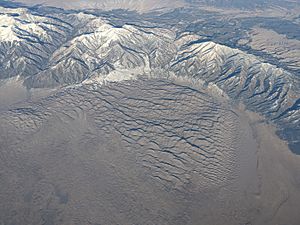
The main winds blow from the southwest, pushing the sand towards a curve in the Sangre de Cristo Mountains. The mountains act like a trap, making the sand pile up. But during storms, the wind can blow back towards the valley. These winds blowing in opposite directions cause the dunes to grow taller and taller.
Two creeks, Medano Creek and Sand Creek, also help. They pick up sand from the mountainside and carry it around the dunes. When the creeks disappear into the sand, the wind picks up the sand again and blows it back into the dune field. This constant recycling of sand by wind and water helps create these huge dunes.
The dunes are not completely dry. A few inches below the surface, the sand is moist. This moisture helps hold the sand together, making the dunes stable and allowing them to grow so tall.
You might see dark patches on the dunes. These are deposits of magnetite, a heavy, magnetic mineral that comes from the mountains. When the lighter sand blows away, the magnetite stays behind, creating these dark spots.
Where is the Park? (Geography)
Great Sand Dunes National Park and Preserve is in Saguache and Alamosa Counties, Colorado. The national park part is in the San Luis Valley, and the national preserve is in the Sangre de Cristo Range of the Rocky Mountains to the east. The elevation here ranges from 7,515 ft (2,291 m) in the valley to 13,604 ft (4,146 m) on top of Tijeras Peak.
The dunes cover about 30 sq mi (78 km2). But the flat, sandy area around them, called the sand sheet, is even bigger. It holds about 90% of all the sand in the park. The tall, often snow-capped mountains to the east are a striking sight.
The park also has creeks fed by snowmelt from the mountains and several alpine lakes. There are also wetlands in the valley, which are important for wildlife.
The closest city is Alamosa, about 30 mi (48 km) southwest by road. Other nearby towns include Crestone, Mosca, and Fort Garland. Larger cities like Colorado Springs and Denver are a few hours away by car.
Climate
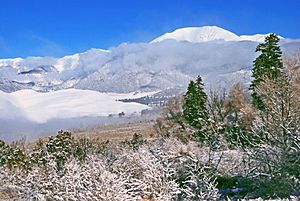
The Great Sand Dunes are in a high-elevation desert area. The weather can change a lot!
In summer, daytime temperatures are usually around 75–80 °F (24–27 °C). But the sand surface can get super hot, up to 150 °F (66 °C)! Summer nights are cool, often dropping below 50 °F (10 °C), because the park is so high up (about 8,200 ft (2,500 m) above sea level). Thunderstorms are common in July and August, bringing cool winds and rain.
Winters are cold, with temperatures often below freezing. But there's usually a lot of sunshine. Spring can be mild or snowy, with strong winds. March is often the snowiest month. The park gets about 11.13 inches (283 mm) of rain each year, which is not much for a desert.
| Climate data for Great Sand Dunes National Park and Preserve, Colorado, 1991–2020 normals, extremes 1950–present | |||||||||||||
|---|---|---|---|---|---|---|---|---|---|---|---|---|---|
| Month | Jan | Feb | Mar | Apr | May | Jun | Jul | Aug | Sep | Oct | Nov | Dec | Year |
| Record high °F (°C) | 67 (19) |
63 (17) |
72 (22) |
78 (26) |
89 (32) |
96 (36) |
94 (34) |
90 (32) |
87 (31) |
80 (27) |
67 (19) |
61 (16) |
96 (36) |
| Mean maximum °F (°C) | 46.8 (8.2) |
51.3 (10.7) |
63.2 (17.3) |
70.2 (21.2) |
78.4 (25.8) |
86.9 (30.5) |
88.3 (31.3) |
85.7 (29.8) |
81.0 (27.2) |
72.7 (22.6) |
60.1 (15.6) |
49.1 (9.5) |
89.2 (31.8) |
| Mean daily maximum °F (°C) | 33.4 (0.8) |
38.8 (3.8) |
48.5 (9.2) |
55.8 (13.2) |
65.9 (18.8) |
77.4 (25.2) |
80.8 (27.1) |
78.1 (25.6) |
71.6 (22.0) |
59.6 (15.3) |
45.5 (7.5) |
34.1 (1.2) |
57.5 (14.2) |
| Daily mean °F (°C) | 22.3 (−5.4) |
27.5 (−2.5) |
36.1 (2.3) |
42.5 (5.8) |
51.9 (11.1) |
62.5 (16.9) |
66.3 (19.1) |
64.1 (17.8) |
57.5 (14.2) |
46.2 (7.9) |
33.6 (0.9) |
23.1 (−4.9) |
44.5 (6.9) |
| Mean daily minimum °F (°C) | 11.3 (−11.5) |
16.2 (−8.8) |
23.7 (−4.6) |
29.2 (−1.6) |
37.8 (3.2) |
47.6 (8.7) |
51.7 (10.9) |
50.0 (10.0) |
43.5 (6.4) |
32.8 (0.4) |
21.6 (−5.8) |
12.0 (−11.1) |
31.5 (−0.3) |
| Mean minimum °F (°C) | −4.1 (−20.1) |
−0.9 (−18.3) |
7.2 (−13.8) |
15.0 (−9.4) |
25.1 (−3.8) |
36.0 (2.2) |
44.5 (6.9) |
42.9 (6.1) |
31.3 (−0.4) |
16.1 (−8.8) |
4.2 (−15.4) |
−3.9 (−19.9) |
−7.6 (−22.0) |
| Record low °F (°C) | −25 (−32) |
−22 (−30) |
−9 (−23) |
−6 (−21) |
15 (−9) |
25 (−4) |
36 (2) |
33 (1) |
22 (−6) |
0 (−18) |
−12 (−24) |
−19 (−28) |
−25 (−32) |
| Average precipitation inches (mm) | 0.58 (15) |
0.44 (11) |
0.88 (22) |
1.19 (30) |
1.19 (30) |
0.73 (19) |
2.10 (53) |
1.92 (49) |
1.31 (33) |
0.86 (22) |
0.51 (13) |
0.49 (12) |
12.20 (310) |
| Average snowfall inches (cm) | 8.1 (21) |
6.2 (16) |
8.5 (22) |
7.9 (20) |
1.7 (4.3) |
0.0 (0.0) |
0.0 (0.0) |
0.0 (0.0) |
0.0 (0.0) |
2.8 (7.1) |
5.6 (14) |
7.0 (18) |
47.8 (121) |
| Average precipitation days (≥ 0.01 in) | 4.9 | 5.2 | 5.6 | 6.1 | 7.3 | 5.2 | 10.2 | 11.3 | 7.1 | 5.4 | 4.0 | 5.4 | 77.7 |
| Average snowy days (≥ 0.1 in) | 5.3 | 5.1 | 4.5 | 4.3 | 0.9 | 0.0 | 0.0 | 0.0 | 0.0 | 1.7 | 3.4 | 5.6 | 30.8 |
| Source: NOAA | |||||||||||||
Nature and Wildlife (Ecology)
The Great Sand Dunes system has four main parts: the mountain watershed, the dune field, the sand sheet, and the sabkha.
The mountains get lots of snow and rain. This water feeds creeks that flow down through forests and around the dunes. These creeks pick up sand and carry it back to the valley. When the creeks disappear into the sand, the wind picks up the sand and blows it back to the dunes. This amazing cycle of water and wind helps the dunes grow so tall.
The dune field has different types of dunes, including star dunes which are the tallest. The sand sheet is a large area of sandy grasslands around the dunes. It holds most of the sand in the park. Small dunes form in the sand sheet and then move into the main dune field.
The sabkha is a wetland area where groundwater comes to the surface. When the water dries up, it leaves behind a white crust, like baking soda. Some sabkha wetlands are deep with lots of plants and animals, while others are shallow and salty.
Plants (Flora)
Hundreds of plant species live in the park, from high mountain areas to warm wetlands. Some common trees include aspen, Douglas fir, pinyon pine, and ponderosa pine.
You can also find beautiful flowering plants like alpine phlox, alpine forget-me-not, paintbrush flowers, and prairie sunflower. In the wet sabkha areas, you'll see inland saltgrass.
Animals (Fauna)

Many different mammals live here, from tiny pikas in the mountains to large elk and bison in the grasslands. You might also spot yellow-bellied marmots, bighorn sheep, black bears, cougars, coyotes, and beavers.
Over 250 types of birds have been seen in the park. Some common birds include the peregrine falcon, mountain bluebird, burrowing owl, bald eagle, and sandhill crane.
The park is also home to various reptiles like the short-horned lizard and bullsnake. In the streams, you can find Rio Grande cutthroat trout. Amphibians like the tiger salamander and different kinds of toads also live here.
The Great Sand Dunes even have special endemic insects, meaning they are found nowhere else in the world! These include the Great Sand Dunes tiger beetle.
Ecosystems
The park has several different ecosystems:
- Alpine Tundra: This is the highest area, where it's too harsh for trees. But wildflowers, pikas, and bighorn sheep thrive here.
- Subalpine Forests: These forests are found just below the tundra. They get lots of snow and rain. Many different Rocky Mountain animals and plants live here.
- Montane Forests and Woodlands: These are drier forests at lower elevations. You'll find pinyon-juniper and ponderosa pine trees. Cougars and owls live in these areas.
- Riparian Zones: These are areas along creeks. Trees like cottonwood and aspen grow here, providing shade and homes for animals like black bears and Rio Grande cutthroat trout.
- Dune Field: Even though it looks dry, the dunes are moist just below the surface. This allows special plants and insects, like the Great Sand Dunes tiger beetle, to live here. Many animals from other areas also visit the dunes.
- Sand Sheet: These are grasslands and shrublands around the dunes. Elk and pronghorn are common here, and burrowing owls nest in the ground.
- Sabkha and Wetlands: These are wet areas where groundwater comes up. Sandhill cranes, shore birds, and amphibians use these important habitats.
Special Features
The park is famous for its tall sand dunes, but it also has alpine lakes, mountain peaks over 13,000 feet (4,000 m) high, forests, grasslands, and wetlands.
One unique feature is Medano Creek, which flows along the east side of the dunes. The sand in the creek bed constantly shifts, creating small underwater ridges. When these ridges break, they create "surges" of water that look like waves! This "surge flow" is strongest in late May to early June.
Big Spring Creek is another special place. It's a spring-fed creek that creates wetlands. These wetlands are home to rare plants and animals in an otherwise dry area.
Fun Things to Do (Recreation)
To reach the dunes, you usually have to walk across Medano Creek. In spring (late April to late June), the creek flows strongly, but in other months, it's usually just a few inches deep or dry.
You can hike anywhere on the dunes, but be careful in summer because the sand can get extremely hot (up to 150 °F (66 °C)). If you need help, sand wheelchairs are available at the visitor center.
Sandboarding and sandsledding are very popular activities! You can rent special boards and sleds just outside the park entrance or in Alamosa.

There are also great hiking trails in the park and preserve:
- Mosca Pass Trail: This 7 mi (11 km) roundtrip hike follows a creek through forests to Mosca Pass.
- Alpine Lake Trails: Trails in the northeastern part of the park lead to beautiful alpine lakes high in the mountains, like Medano Lake and Sand Creek Lakes. You can even hike to the top of Mount Herard!
- Sand Ramp Trail: This trail connects the park's campground to Medano Pass Road and the Sand Creek Trail.
If you have a street-legal four-wheel drive (4WD) vehicle, you can drive on Medano Pass Road. This 22 mi (35 km) unpaved road crosses Medano Creek nine times and goes through deep sand. It winds through a mountain canyon and over Medano Pass. Only 4WD vehicles, motorcycles, and fat tire bikes are allowed.
You can also go horseback riding and bring pack animals in most of the national park and the entire national preserve. There are special rules about where you can ride and camp with horses.
Hunting is allowed in the national preserve during certain seasons, but it is never allowed inside the national park boundaries.
Park Designations
The Great Sand Dunes area was first made a national monument in 1932. This was thanks to local support and a bill signed by President Herbert Hoover.
In 2000, with more local support, it was decided to make it a national park and preserve. This change officially happened in 2004, making the protected area much larger.
In 1976, a large part of the monument became the Great Sand Dunes Wilderness. A wilderness area is a place where nature is protected and human activities are limited. No cars or motorized equipment are allowed in wilderness areas. This helps protect animals like the special Great Sand Dunes tiger beetle.
In 1999, a group called the Nature Conservancy bought land next to the park. This land, called Medano–Zapata Ranch, is now partly within the park boundaries. It includes an area with a bison herd that you can visit on a guided tour.
In 2019, Great Sand Dunes National Park and Preserve was named an International Dark Sky Park. This means it's a great place to see the stars and the Milky Way because there's very little light pollution.
Images for kids
-
Aspens in a riparian zone
See also
 In Spanish: Parque nacional y reserva Grandes Dunas de Arena para niños
In Spanish: Parque nacional y reserva Grandes Dunas de Arena para niños




